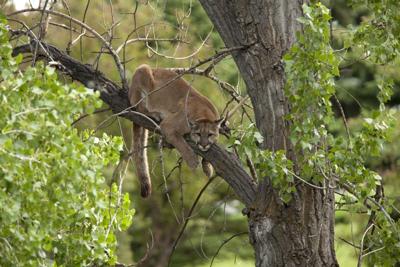A male runner killed a mountain lion on Monday afternoon after it attacked him in Horsetooth Mountain Open Space near Fort Collins, Colorado. The man was bitten multiple times, receiving wounds on his face, arms, legs, back, and wrist.
While the victim was defending himself, the attacking animal, described as a “juvenile mountain lion,” was killed.
UPDATE: Man killed mountain lion by suffocation
According to the account of the attack, the runner heard a noise behind him and stopped to investigate. This is when the mountain lion lunged at the runner, grabbing ahold of him with his teeth. The runner fought back in self-defense, killing the animal in the process. The runner sustained serious injuries, though they weren’t life threatening.
RELATED: 6 Things to Know About Mountain Lions in Colorado
Authorities returned to the scene and found the mountain lion where the runner had described it would be. The incident occurred on West Ridge Trail. A necropsy is being conducted to determine exactly what killed the lion.
According to the Larimer County website, Horsetooth Mountain Open Space is 2,711 acres in size with 29 miles of trails. Though close to Fort Collins, it is located in the foothills of Horsetooth Mountain.
Mountain lion attacks are rare, as mountain lions prefer to avoid human interactions.
An apex predator found around the state of Colorado, mountain lions are seldom seen, but often a topic of conversation. Here are a few things you should know about this amazing creature.
UPDATE: Man killed mountain lion by suffocation
1. There are an estimated 3,000 to 7,000 mountain lions in Colorado.
Due to secretive nature typical of a mountain lion, their numbers can be difficult to track. Most recent data released by Colorado Parks and Wildlife indicates that there may be as many as 7,000 in Colorado. That’s more than 6 per 100 square miles making up nearly a quarter of the country’s lion population.
2. Mountain lion attacks on humans are rare.
Mountain lions are typically skittish animals when it comes to humans, often opting to avoid contact altogether. That being said, as development continues to move into once-wild terrain around Colorado, mountain lions are being seen more frequently in towns and cities. As mountain lions get bolder, one would assume that the risk of attack will also increase.
When attacks do occur, lions generally target small humans that are alone. A couple notable mountain lion attacks in Colorado include a 1997 case in which a 10-year-old boy was killed while hiking ahead of his family in Rocky Mountain National Park, as well as a 2016 incident in which a mother fought a mountain lion off of her 5-year-old son. That boy survived.
3. Mountain lions hunt big game.
Typically most active during dusk and dawn, the staple of a mountain lion’s diet is deer. They’ll also eat elk, livestock, and smaller mammals, as well as domestic animals including cats and dogs.
Lions tend to hunt in a similar fashion to most cats, which involves stalking and ambush. They use their powerful bite to break the neck of their prey.
4. Mountain lions can have a massive range.
Typically loners, the territory range of a mountain lion can be anywhere from 10 miles to 370 miles. A key factor in determining the size of the range is availability of food. Once a lion claims its territory, it marks it’s zone with piles of dirt and sticks to ward off other big cats.
5. Mountain lions are big.
Mountain lions can exceed 8 feet in length, weighing an average of 150 pounds. The largest of mountain lions can weigh more than 200 pounds. As with many species, male mountain lions tend to be larger than females. How’s that compare to a lion you’d find in Africa? The largest of those can reach over 9 feet in length and weigh more than 500 pounds.
6. Mountain lions are extremely athletic.
The largest wildcat in North America, mountain lions are known for their agility and jumping ability. They can jump as high as 15 feet and as far as 40 feet. This is one reason why they’re so effective at hunting.







(0) comments
Welcome to the discussion.
Log In
Keep it Clean. Please avoid obscene, vulgar, lewd, racist or sexually-oriented language.
PLEASE TURN OFF YOUR CAPS LOCK.
Don't Threaten. Threats of harming another person will not be tolerated.
Be Truthful. Don't knowingly lie about anyone or anything.
Be Nice. No racism, sexism or any sort of -ism that is degrading to another person.
Be Proactive. Use the 'Report' link on each comment to let us know of abusive posts.
Share with Us. We'd love to hear eyewitness accounts, the history behind an article.